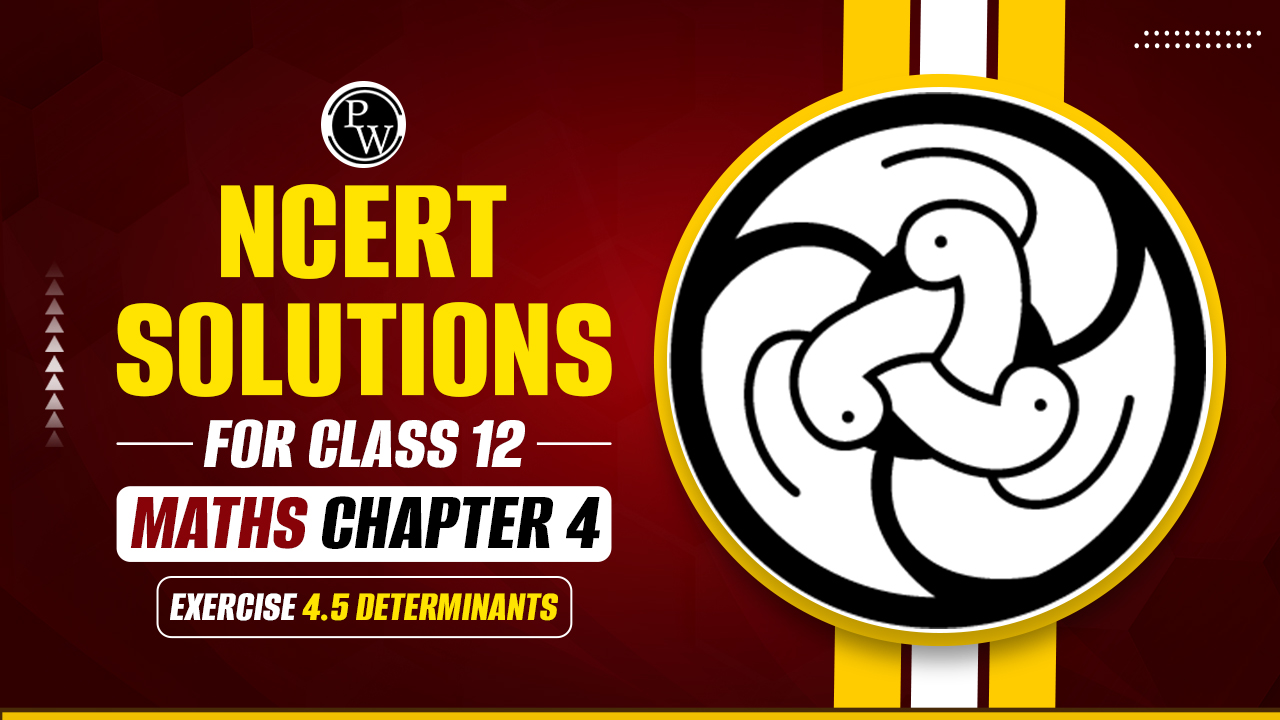NCERT Solutions for Class 12 Maths Chapter 4 Exercise 4.5 Determinants

Class 12 Maths Chapter 4 Exercise 4.5 Determinants:- Chapter 4 of Class 12 Maths focuses on Determinants, which are mathematical objects that are useful in various areas of mathematics and beyond. Exercise 4.5 of this chapter typically builds on the concepts introduced earlier, involving further practice and application of determinant properties and operations. It often includes problems that explore the calculation of determinants of matrices of higher order, applications of properties like row operations and cofactor expansions, and sometimes, problems related to consistency and linear independence of systems of equations using determinants. Go through the NCERT Solutions for Class 12 Maths Chapter 4 Exercise 4.5 Determinants in the below article.
NCERT Solutions for Class 12 Maths Chapter 4 Exercise 4.5 Determinants
Practise CBSE Class 12th Maths with Physics Wallah’s NCERT Solutions. Here are the NCERT Solutions for Class 12 Maths Chapter 4 Exercise 4.5 Determinants below.
Find adjoint of each of the matrices in Exercise 1 and 2.
Question1.
Solution :
Question2.
Solution :
Question 3.
Verify A (adj A) = (adj A) A = |A| I .
Solution :
Question 4.
Verify A (adj A) = (adj A) A = |A| I .
Solution :
Let A =
Find the inverse of the matrix (if it exists) given in Exercise 5 to 11.
Question 5.
Solution :
Check out: CBSE Class 12th Books
Question6.
Solution :
Question 7.
Solution :
Question 8.
Solution :
Question 9.
Solution :
Question 10.
Solution :
Let A =
Question 11.
Solution :
Check out: Class 12 Mathematics Question & Concept Bank
Question 12. Let
Solution :
Question 13. If A =, show that A2 – 5A + 7I = 0. Hence find A-1
Solution :
Question 14. For the matrix A = find numbers a and b such that A2 + aA + bI = O.
Solution :
Question 15. For the matrix A =, show that A3 − 6A2 + 5A + 11 I = O. Hence, find A−1.
Solution :
Question 16. If A =, verify that A3 − 6A2 + 9A − 4I = O and hence find A−1
Solution :
Check out: Class 12th Sample Papers
Question 17. Let A be a non-singular matrix of order 3 x 3. Then |adjA| is equal to:
(A) |A|
(B) |A|2
(C) |A|3
(D) 3|A|
Solution :
Therefore, option (B) is correct.
Question 18. If A is an invertible matrix of order 2, then det (A−1) is equal to:
(A) det A
(B) 1/det A
(C) 1
(D) 0
Solution :
Therefore, option (B) is correct.
Class 12 Maths Chapter 4 Exercise 4.5 Determinants Summary
-
Higher Order Determinants: Problems involving the calculation of determinants of matrices of higher dimensions (typically 3x3 or higher), applying the properties of determinants such as expansion by minors or cofactor expansion.
-
Applications of Determinants: Problems that apply determinants to solve systems of linear equations, checking consistency, and exploring the concept of linear dependence or independence of vectors.
-
Properties and Operations: Practice in using properties like row operations (like switching rows or multiplying rows by constants) to simplify determinants or matrices.
-
Conceptual Understanding: Questions that reinforce the conceptual understanding of determinants, their significance in linear algebra, and their applications in various fields including physics and engineering.
Check out: School Books
Class 12 Maths Chapter 4 Exercise 4.5 Determinants FAQs
Q1. What are determinants used for in mathematics?
Ans. Determinants are used to solve systems of linear equations, calculate areas and volumes in geometry, find inverses of matrices, and determine the consistency of systems of equations.
Q2. How do you find the determinant of a 3x3 matrix?
Ans. The determinant of a 3x3 matrix AAA is calculated using the formula: det(A)=a11(a22a33−a23a32)−a12(a21a33−a23a31)+a13(a21a32−a22a31)\text{det}(A) = a_{11}(a_{22}a_{33} - a_{23}a_{32}) - a_{12}(a_{21}a_{33} - a_{23}a_{31}) + a_{13}(a_{21}a_{32} - a_{22}a_{31})det(A)=a11(a22a33−a23a32)−a12(a21a33−a23a31)+a13(a21a32−a22a31)
Q3. What are the properties of determinants?
Ans. Properties include linearity, multiplicativity by scalar, determinant of identity matrix, determinant of transpose, and effect of row operations.
Q4. How do determinants relate to matrices?
Ans. Determinants are associated with square matrices and provide information about the matrix's properties, such as invertibility and volume scaling factor.
Q5. What does a zero determinant indicate?
Ans. A zero determinant indicates that the matrix is singular (not invertible), implying linear dependence among its rows or columns.










